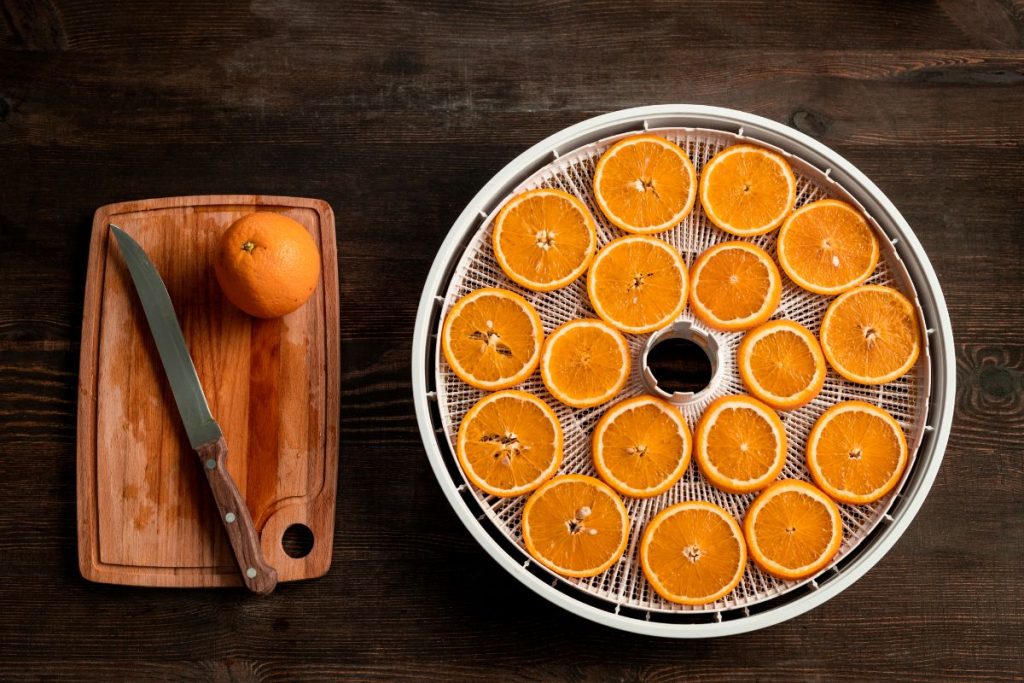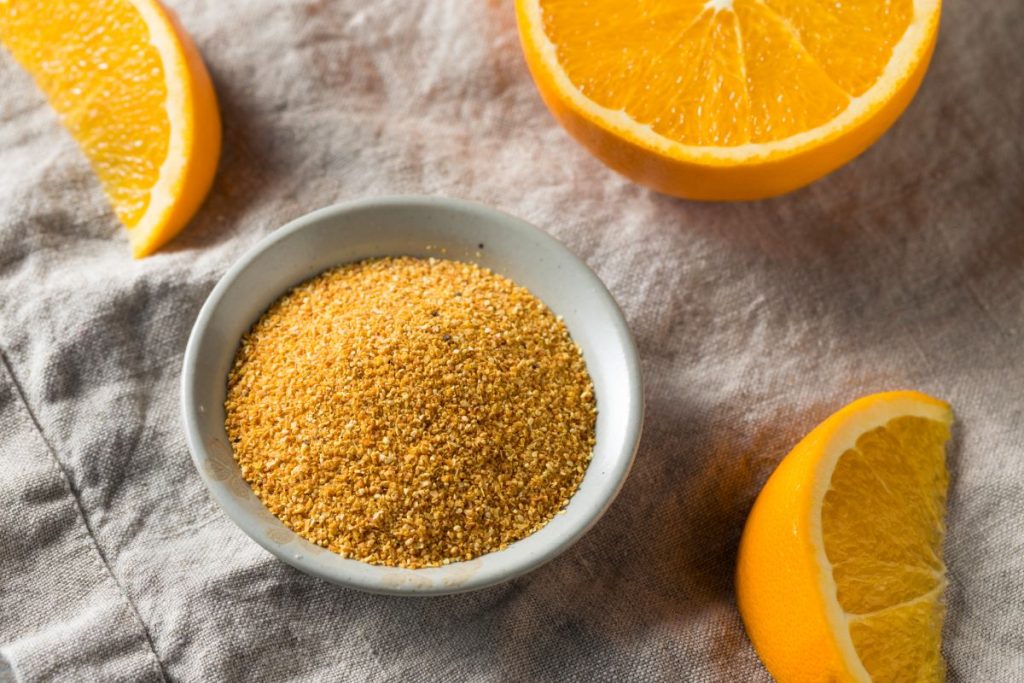The best way to dehydrate oranges is in a food dehydrator. Wash fresh oranges and cut them into thin slices. Place the slices on dehydrator trays in a single layer and dehydrate them at 135°F for 6-9 hours.
Table of Contents
How to Dehydrate Oranges in a Food Dehydrator
The best method for dehydrating oranges is to use a food dehydrator. Oranges dried in a food dehydrator have a lighter color and a low risk of burning.
Follow these steps for drying oranges in an electric dehydrator:
- Choose oranges to dehydrate by assessing freshness, firmness, size, and type. Choose smaller varieties that fit easily into jars, such as Cara Cara, Cutie, Mandarin, Valencia, Tangelo, Seville, Clementine, blood oranges, or navel oranges.
- Preheat the food dehydrator to 135°F.
- Wash the oranges under cool running water to remove any wax and residue on the rind.
- Use paper towels or tea towels to remove water from the surface of the oranges.
- Use a sharp knife/serrated knife or mandoline slicer to cut the oranges into uniform, round, unpeeled slices that are 1/8 or 1/4-inch thick. Alternatively, peel the oranges first, then separate the interior flesh into crescent moon-shaped sections, removing the bitter pith.
- Remove the seeds if your oranges have them.
- Use paper towels to dab the slices or sections to remove excess juice.
- Arrange the citrus slices or sections on dehydrator trays in single layers with enough space between them for airflow.
- Place the loaded trays in the dehydrator and dehydrate the oranges at 135°F for 6-9 hours.
- If your dehydrator’s fan is at the bottom, rotate the trays to ensure even drying. For horizontal flow models, flip the orange pieces over after the second hour and every 30-45 minutes afterward. Dehydrate the oranges until they are fully dry.
- Take out a few pieces and cool them to room temperature to test for dryness. They should easily snap when you bend them and have a matte surface that is not sticky to the touch.
- If the pieces are thoroughly dry, take the trays out of the dehydrator and cool the batch to room temperature before conditioning them in airtight containers like glass jars for up to seven days.
- Once conditioned, store dehydrated oranges in labeled, airtight containers in a cool, dry location.

How Do You Dehydrate Oranges in the Oven?
Drying citrus fruits in an oven is more difficult because there is a higher risk of burning them due to the higher temperature in an oven. Combat this by keeping the oven door propped open, using the lowest temperature setting for the oven, and keeping a close eye on the oranges as they are drying.
Here’s how to make oven-dried orange slices and sections:
- Prepare your selected oranges by washing them and cutting them into slices or sections. Remove any seeds and pat them dry to reduce moisture.
- Preheat the oven to 175°F or the lowest temperature. Turn on the convection option if your oven has it.
- Place a large non-stick wire rack on a baking tray or line a baking sheet with parchment paper. The wire cooling rack is better than baking paper at preventing scorching.
- Place the slices or sections in a single layer with enough space for air to flow around the pieces. Place the tray in the oven.
- Dehydrate the oranges for 3-4 hours. Keep the oven door propped open slightly to allow humidity to escape and to promote airflow.
- Flip the orange sections or slices every 30 minutes to dry uniformly and avoid browning.
- Once the oranges are dried, cool a few pieces to room temperature to test for dryness. They should be leathery, crunchy, and brittle. Continue dehydrating them if they aren’t fully dry.
- Once the oranges are dried, remove them from the oven and cool them to room temperature. Condition them for 7 days to ensure they are fully dried, then label and store them in a cool, dark place.

Do You Peel Oranges Before Dehydrating Them?
If dehydrating orange sections, the rind and pith should be removed. When dehydrating orange slices, you can leave the skin intact.
What Can You Do With Removed Orange Peels?
Discard orange peels or remove the zest from the skin with a grater. Orange zest can be used fresh or dried into a powder and used in baked goods and recipes that call for aromatics.

What are the Benefits of Dehydrating Oranges?
Enjoy the following benefits when you dehydrate fresh oranges:
- Dehydrated oranges are easier to store as they require less space
- Dehydrating preserves the freshness of oranges by improving their shelf life
- Dehydration concentrates the sweetness and flavor of oranges
- Dried citrus fruits like oranges and limes are rich in potassium, which keeps electrolytes in balance
- Oranges are an excellent source of vitamin C, which boosts the immune system
- Oranges contain calcium, manganese, and phosphorus.
- The dietary fiber in dried oranges may help regulate blood sugar levels and cholesterol
What Do Dehydrated Oranges Look Like?
Oranges retain their color after drying. For example, blood oranges will retain their crimson-red color. However, dried oranges will turn brown if they burn or are exposed to too much heat during the drying process.
Oranges will also shrink in size when dehydrated due to moisture loss and may be somewhat translucent in the middle, depending on the thickness of the slices.

What Temperature Do You Dehydrate Oranges At?
The ideal temperature to dehydrate oranges in a food dehydrator is 135°F-140°F. 135°F passes as the “fruit setting” on most dehydrators. You can go lower, but the total time to dry them will be extended.
For the oven, the best temperature for dehydrating is the lowest setting or 175°F. The temperature can be set as high as 200°F, but the risk of burning the oranges increases.
How to Eat Dehydrated Oranges
You can use dried orange slices in many ways:
- Add them to homemade trail mixes or granola bars
- As a cocktail garnish alongside dried cranberries and rosemary sprigs
- As a healthy snack, when peeled
- Dip in melted chocolate for a sweet dessert
- Grind them into orange powder for flavoring baked goods
- Rehydrate them in orange juice and blend them into smoothies
- To add color to mulled drinks and mulling spice mixes
Decorative Uses of Dehydrated Oranges
The utility of dehydrated oranges goes beyond food. Dried oranges are often used during the holiday season for home decor.
- Add them to homemade aromatherapy candles for their citrus scent
- Make DIY orange garlands for Christmas trees and holiday decor
- Make potpourri by combining dehydrated orange slices and cinnamon sticks
- String dry orange slices together and hang above a mantel
- Use slices tied to gift wrap, tags, and recipe cards

Shelf Life of Dehydrated Oranges
The shelf life of homemade dehydrated oranges is two years when stored properly at room temperature. You can extend their storage duration by a few months by keeping them in vacuum-sealed Mylar bags or glass jars with oxygen absorbers.
Avoid freezing or refrigerating dehydrated citrus fruits like oranges. The freezer and refrigerator are humid environments, and your dry fruits may get moist and rot.
How to Store Dehydrated Oranges
The best storage containers for dehydrated oranges are vacuum-sealed Mylar bags or glass jars such as Mason jars. These are airtight containers that won’t allow moisture to infiltrate them.
Store jarred or bagged dehydrated oranges at room temperature in a cool, dark, dry place.

